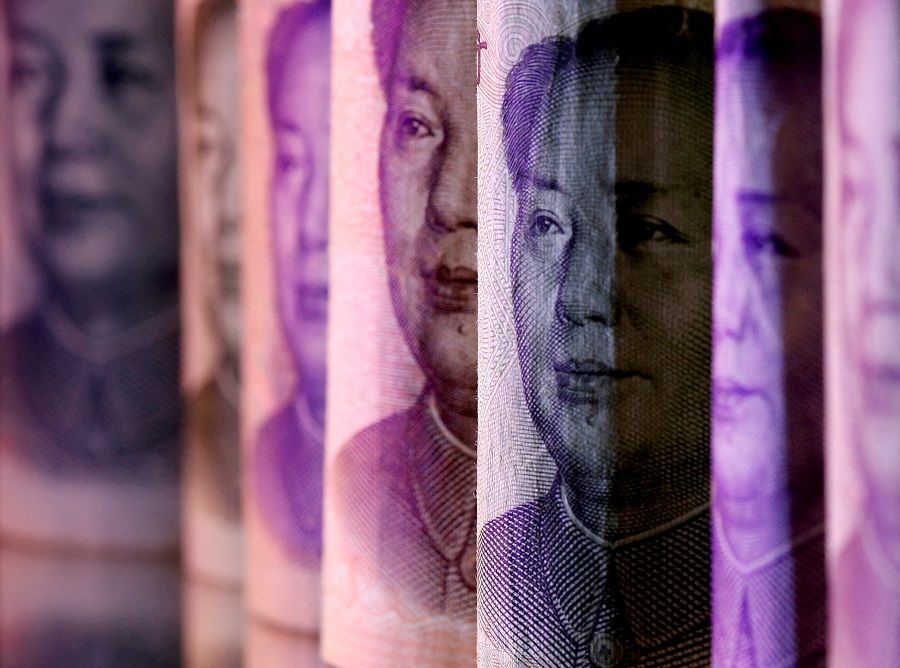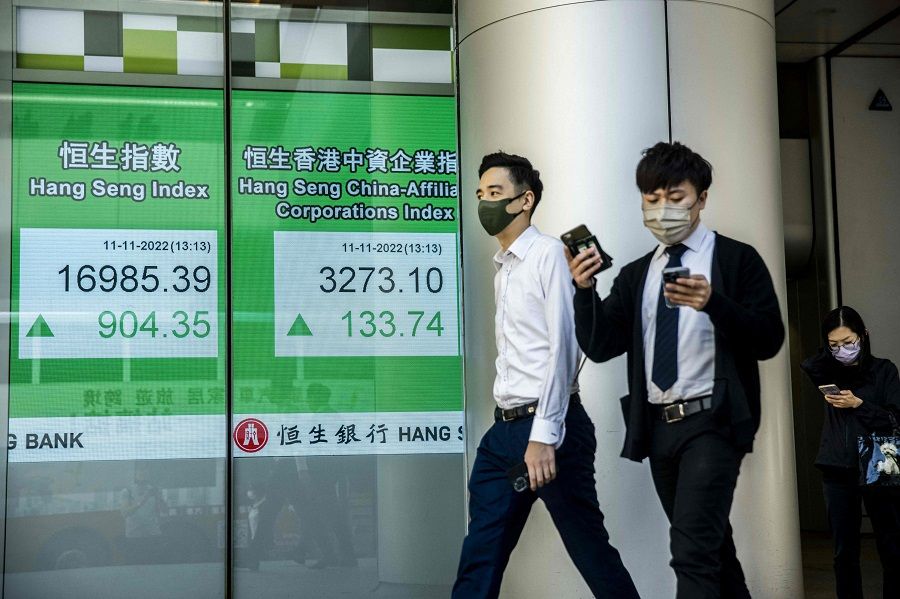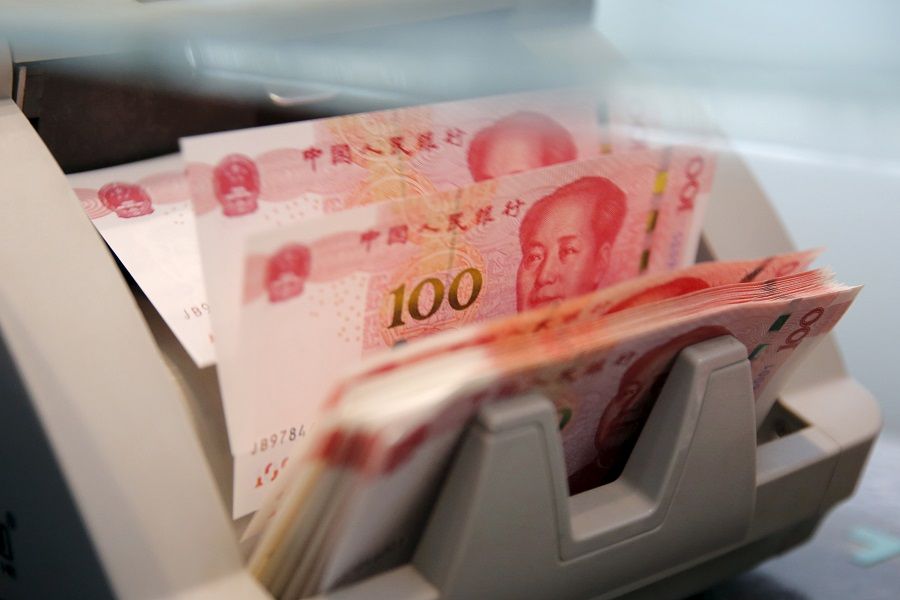What's in store for RMB internationalisation in 2023?

(By Caixin journalists Wang Xiaoqing and Zhang Ziyu)
Internationalisation of the renminbi (RMB) made significant progress in 2022 as currency trading and demand from financial institutions outside of the Chinese mainland surged, and more international trade in goods and services was settled in the Chinese currency.
The RMB looks set to gain further traction globally this year, as the People's Bank of China (PBOC) implements the government's strategy to boost the currency's use overseas, which will challenge the dominance of the US dollar in the long term.
Spreading currency risk
An expected recovery in the Chinese economy, and the launch of programmes such as the Swap Connect and RMB-denominated share trading in Hong Kong, are likely to boost offshore demand for the currency. More companies and financial institutions are expected to issue RMB-denominated bonds, known as "dim sum" bonds, in Hong Kong and other offshore markets as rising US interest rates have led to a sharp increase in the cost of issuing dollar bonds.
The use of the RMB for trade settlement is also expected to grow. Many countries, including Russia and those in Southeast Asia, are increasingly using the Chinese currency to settle imports and exports.
The financial sanctions on Russia reflect how the US has weaponised its financial policy, and that has triggered concerns in some sections of the international community about whether they will also be subject to sanctions if they behave in ways that are inconsistent with the American model or if there are conflicts in diplomatic and commercial interests, said Chris Leung, chief China economist at DBS Bank in Hong Kong. As a result, they are choosing to spread their currency risks, he said.

The RMB is now one of the most actively traded currencies in the world. It rose to fifth place in over-the-counter (OTC) foreign exchange markets in April 2022 from eighth in the same month in 2019, according to a triennial survey of central banks by the Bank for International Settlements (BIS) published in October.
Market share surges
Although the RMB was still way behind the US dollar - by far the most-traded currency - the euro, the Japanese yen and the British pound, it was traded more than the Canadian dollar and the Swiss franc, according to the survey that covered five markets - spot trading, foreign-exchange swaps, forwards, options and currency swaps.
In general, investors must acquire RMB offshore rather than buy it onshore using foreign exchange, which has led to rising demand for the Chinese currency outside of the mainland...
The RMB showed the biggest increase in market share of all currencies since the BIS' previous survey in 2019 - on a daily average, it was on one side of 7% of all trades in April 2022, up from 4% in the same month three years earlier. Just over 80% of foreign-exchange trading in RMB took place in offshore markets, according to the BIS survey, up from 72% in 2019, pushing the share of trading on the Chinese mainland down to 17.4% from 28%.
The RMB's growing popularity is being driven partly by the further opening of China's capital markets to overseas investment. In general, investors must acquire RMB offshore rather than buy it onshore using foreign exchange, which has led to rising demand for the Chinese currency outside of the mainland in financial markets such as Hong Kong, London and Singapore.
The RMB is also becoming a more popular currency for companies and institutions to raise money. The issuance of dim sum bonds almost tripled year-on-year to 231.6 billion RMB ($34.3 billion) in the first ten months of 2022, and the number of issuers rose to 376 from 142, according to data compiled by Refinitiv.
In Hong Kong, issuance jumped 87% to 109.6 billion RMB in 2021 and, according to Darryl Chan Wai-man, a deputy chief executive of the Hong Kong Monetary Authority (HKMA), issuance in the first ten months of 2022 amounted to more than 100 billion RMB, the most for that period since 2014.

Russian companies emerged as players in the dim sum bond market in 2022 as sanctions imposed by the US and other Western countries on Moscow following its invasion of Ukraine forced them to cut their dependence on the US dollar for business and investment.
Aluminium producer United Co. Rusal International PJSC, which is listed in Hong Kong and Moscow, issued the first-ever RMB-denominated bond in Russia in August, raising 4 billion RMB. As of November, seven issuances of RMB-denominated bonds totalling 31 billion RMB were trading on the Moscow Exchange, according to Russian news agency TASS. The exchange announced on 11 November that it was launching an index of Russian bonds denominated in RMB.
The bonds have been snapped up in Russia as the growing use of the Chinese currency in trade settlement as a result of Western sanctions has created a large pool of RMB looking for financial instruments to invest in, Natalia Yatsenko, executive director of debt capital markets at Gazprombank, told Caixin. The Moscow Exchange is also planning to introduce issuance and trading of RMB-denominated fixed-income swaps and other derivatives.
Meanwhile, local governments on the Chinese mainland are turning to offshore markets to raise money. In October 2021, Shenzhen city and Guangdong province issued the first direct offshore bonds offered by local-level mainland governments in Hong Kong and Macau respectively, followed by the provincial government of Hainan's bond sales in Hong Kong in October 2022.
Growth is being fuelled by trade and economic integration, especially in Asia, and by the increased willingness of China's trade partners to settle in RMB rather than dollars.
Trade settlement jumps
Use of the RMB in cross-border trade settlement is also rising. In 2021, RMB settlement jumped 20.7% to 5.77 trillion RMB for trade in goods, accounting for 14.7% of total cross-border goods trade settlement, according to the PBOC's 2022 RMB Internationalisation Report. In the first half of 2022, the figure jumped 31.2% year-on-year to 3.48 trillion RMB, accounting for 16.6% of the total, it said.
Growth is being fuelled by trade and economic integration, especially in Asia, and by the increased willingness of China's trade partners to settle in RMB rather than dollars.

The long-term, steady trade relationship between China and the ten member states of the Association of Southeast Asian Nations (ASEAN) provides an ideal structure for promoting trade settlement in RMB, said Liao Qun, chief economist of the Chongyang Institute for Financial Studies at Renmin University of China in Beijing.
China is not only one of ASEAN's largest trading partners but is becoming one of its leading investors. Its growing role in funding infrastructure in the region provides the opportunity to increase the use of the RMB for investment, Liao said.
The launch of the Regional Comprehensive Economic Partnership - a free trade agreement between ASEAN and five other Asia-Pacific nations including China - will help accelerate the use of the RMB in trade settlement, said Karen Ng, managing director and head of China Opening and RMB Internationalisation at Standard Chartered Bank.
Cross-border trade settlement in RMB is also gaining ground outside of Asia, especially in Russia as a result of Western sanctions.
The PBOC has been putting the financial market infrastructure in place to facilitate RMB settlement. It has authorised RMB clearing banks in Singapore, Malaysia, the Philippines and Thailand and put in place currency swap, settlement or cooperation agreements with eight of the ten ASEAN member states.
Cross-border trade settlement in RMB is also gaining ground outside of Asia, especially in Russia as a result of Western sanctions. State energy giants Gazprom PJSC and China National Petroleum Corp. signed an agreement in September under which China would begin to pay for Russian natural gas supplies exclusively in RMB and rubles, instead of US dollars. Last year, some Indian companies started paying for coal imports in RMB rather than US dollars.
Hong Kong shines
Hong Kong, already the biggest offshore RMB market, is spearheading the government's drive to internationalise the currency.
In its 14th Five-Year Plan unveiled in March 2021, China vowed to strengthen Hong Kong as a "global offshore RMB business hub". The city's financial authorities have a three-pronged strategy, Edmond Lau, a former deputy chief executive of the HKMA, told Caixin - increase offshore RMB liquidity, introduce more RMB-denominated financial products, and improve financial infrastructure to facilitate use of the currency.

The city, which accounted for 34% of RMB trading in offshore OTC forex markets in April 2022 according to the BIS survey, has a deep pool of RMB deposits, amounting to 892.3 billion RMB at the end of November, data released by the HKMA, the city's de facto central bank, show. These deposits support offshore RMB settlement in the city, which accounts for over 70% of RMB payments outside the Chinese mainland, according to the Society for Worldwide Interbank Financial Telecommunication.
The city's financial authorities last year announced several new products and agreements to boost RMB liquidity and use of the currency.
In July, the HKMA and the PBOC increased their currency swap facility to 800 billion RMB from 500 billion RMB and upgraded it to a permanent agreement, aiming to allow the authority to better cope with potential RMB liquidity tightness at local banks by offering short-term capital support.
In October, Hong Kong Exchanges and Clearing Ltd., the operator of the city's stock exchange, launched Core Climate, the first international carbon marketplace offering both Hong Kong dollar and RMB settlement for the trading of carbon credits.
More programmes and products are being launched this year to encourage use of the Chinese currency.

One of the main initiatives is the Swap Connect, a programme that will initially allow offshore investors access to the Chinese mainland interest rate swap market using their existing trading and settlement arrangements and allow them to use offshore RMB to trade in the market. Overseas institutions that invest in the onshore bond market have been pushing the authorities to make access to the mainland derivatives market easier and more efficient to help them manage the risks of fluctuating interest rates.
... the pool of offshore RMB is still small, and that demand for RMB stock trading is thin.
The city's stock exchange plans to promote RMB stock trading, encouraging listed companies to issue RMB-denominated shares. The "one stock, two currencies" initiative will remove exchange-rate risk for mainland investors who use the Stock Connect programme to trade equities and increase the variety of RMB investment products for overseas investors. Trading is expected to start in the second quarter after the necessary technical arrangements and a market-maker mechanism have been put in place.
But some analysts doubt that the programme will take off, pointing out that the exchange has allowed RMB-denominated stocks to be traded since the early 2010s, but they have failed to gain popularity. There are more than 35 exchange-traded funds (ETFs) listed in Hong Kong with shares denominated in both RMB and Hong Kong dollars. But trading in the RMB shares has been low. The Tracker Fund of Hong Kong, the biggest ETF in the city, added RMB shares on 19 September, but as of the end of October, daily turnover has been at most 33 million RMB, while daily turnover of the Hong Kong dollar shares has averaged several billion dollars.
One source involved in developing the RMB-denominated stock channel said the pool of offshore RMB is still small, and that demand for RMB stock trading is thin.
Yang Min contributed to this report.
This article was first published by Caixin Global as "In Depth: What's in Store for Yuan Internationalization in 2023?". Caixin Global is one of the most respected sources for macroeconomic, financial and business news and information about China.
